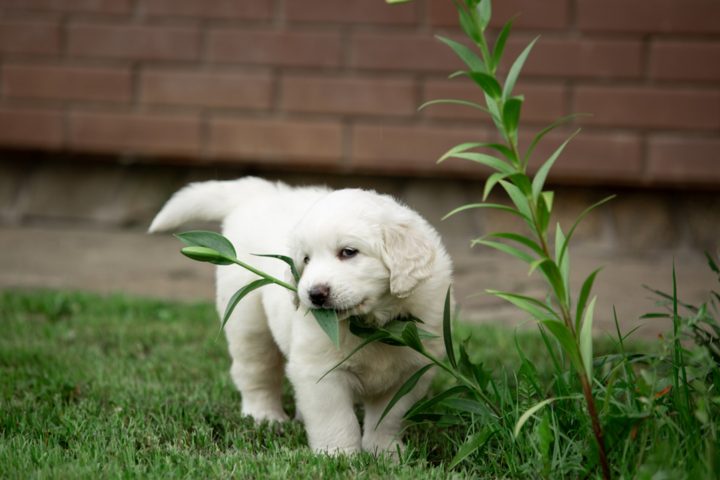Top 5 Toxic Plants For Dogs

Are certainplants toxic to dogs?When dogs like the smell of something, it’s not long before they bite into it. While grass is non-toxic and safe for dogs, the same can’t be said about several other outdoor and ornamental plants. No matter how pretty or fragrant these plants may be, they could also be poisonous for your dog.
Toxic plants are not just found in the city but also in large farms that are home to a host of poisonous wild flowers and plants. Thanks to this, even the best farm dog breeds fall prey to plant poisoning.
If your pup pokes its nose into every bush or flowerpot it comes across, you might want to learn about these plants toxic to dogs.
Sago Palm
Native to the warm regions of Southern China and Japan, this beautiful palm-like plant grows beautifully both indoors and outdoors. If you’re a plant enthusiast, you’re bound to have one of these ornamental plants in your home as they lend a lovely contrast to your decor with their spike leaves and vibrant green hue. However, if you also have a dog at home, Sago Palms are not for you.
Wondering, “What plants should not be around dogs?” Sago Palm is one of them. This plant, including its seeds, contains the highest amounts of a poisonous toxin called cycasin.
If your dog accidentally ingests bits of sago palm, the side effects will set in within 15 minutes. In some cases, it can take up to 12 hours for the symptoms to show.
So, what does Sago Palm do to dogs? Known to damage a dog’s gastrointestinal tract, ingesting Sago Palm causes a range of health problems in dogs. These include vomiting, lethargy, a loss of appetite, sudden weakness, nose bleeds, and seizures.
ALSO READ: Dos and Don’ts: Running with Your Dog
Oleander
Known to have the prettiest white and pink blooms, Oleanders are flowering shrubs that thrive best along the coast. If you live by the beach, you can’t miss spotting several Oleander shrubs along seaside gardens. However, if you take your dog for a walk around these areas, keep it away from Oleanders. This rings especially true if your pet belongs to any of the exotic dog breeds.
From its seeds and stems to its leaves and flowers, every little part of this flowering plant is toxic to dogs. Eating even a speck of Oleander can be deadly for dogs, so you will need to seek immediate medical attention and get appropriate treatment. While the most apparent signs of Oleander poisoning in dogs are vomiting and a lack of appetite, look out for other severe symptoms like cardiac arrhythmia.
Lily Of The Valley
If we’re discussing outdoor plants toxic to dogs, then Lily of the Valley deserves a mention.
Fondly known as the flower of fairies, Lily of the Valley is a herbaceous perennial plant, and it dons the most delicate and exquisite bell-shaped flowers. Almost biblical in nature, this flowering plant is said to ward off evil spirits, but if you have a dog at home, you might want to keep the Lily of the Valley away.
One of the most poisonous plants for dogs, consuming any part of the Lily of the Valley plant, including its roots, can be fatal for dogs. Since this plant carries up to 40 cardiac glycosides and saponins, accidentally ingesting this plant can cause serious or severe heart problems in dogs.
Tulips
An absolute treat to the eyes, love poems and picturesque prose often mention Tulips. Known for their bulb-shaped blooms in striking and bright colors, Tulips make the most amazing bouquets. However, if you’re growing them in your garden, keep your dog away from this flowering plant.
Part of the lily family, tulip plants contain toxins like alkaloids, Tuliposide A, and glycosides. Eating these toxins triggers an array of poisoning symptoms in dogs like seizures, abdominal pain, coma, and even sudden death.
ALSO READ: Cavapoo Dogs – Pros and Cons from Puppies to Adults
Rhododendron
Rhododendrons grow in large bushes, and they feature blooms in a slew of gorgeous hues like red, violet, yellow, white, and pink. Since they thrive in cool and moist climates, you might spot them at your local park if you live in hilly regions or colder parts. If you happen to stumble upon Rhododendron bushes or if you’re planning to grow them in your garden, make sure you don’t have a dog around.
If you’re asking yourself, “What is poisonous to dogs outside?”, beware of Rhododendrons in particular.
Every part of the Rhododendron shrub is poisonous for dogs. This plant contains large amounts of grayanotoxins, which when consumed in small amounts cause hypersalivation, a loss of appetite, impaired vision, weak leg paralysis, and more.
What To Do If Your Dog Has Been Poisoned?
On walks, it’s easier to supervise your dog’s movements. But what happens when you’re home and your dog’s free to roam? If your dog has accidentally eaten a potentially poisonous plant, here’s what you can do.
Remove The Plant From Your Dog’s Proximity
You can’t train your dog to avoid sniffing and eating out of certain pots in the house, so it’s best to keep the plant away from your dog’s proximity. Sago Palms, for example, can be kept at an elevation inside your home and away from your dog’s reach. You could even hang certain plants at a height to make sure your dog doesn’t get to them. Also, you can learn from packaged goods that are bottled and jarred to protect them from pets.
Make Sure Your Dog Is Breathing And Behaving Normally
The most obvious and immediate symptom of toxic plant poisoning is usually characterized by shortness of breath, difficulty in breathing, weakness, and vomiting.
If you know your dog has eaten a toxic plant, don’t panic. First, check to see if it’s breathing and behaving normally.
Call Your Vet Or The Nearest Emergency Veterinary Clinic Immediately
In some cases, if your dog has consumed small doses of plant toxins, symptoms of poisoning take a while to surface. Regardless of the situation, if you’ve seen your dog eat a toxic plant, call your vet and visit the nearest veterinary clinic for a proper diagnosis.
The vet will likely conduct a blood count test and other necessary scans to rule out heart disease and liver damage.
Consuming toxic plants proves harmful for humans as well as pets. If you have little children or pups at home, do your research and plant your garden accordingly. Since prevention is better than cure, you’re better off without plants toxic to dogs that can put their health at risk.


